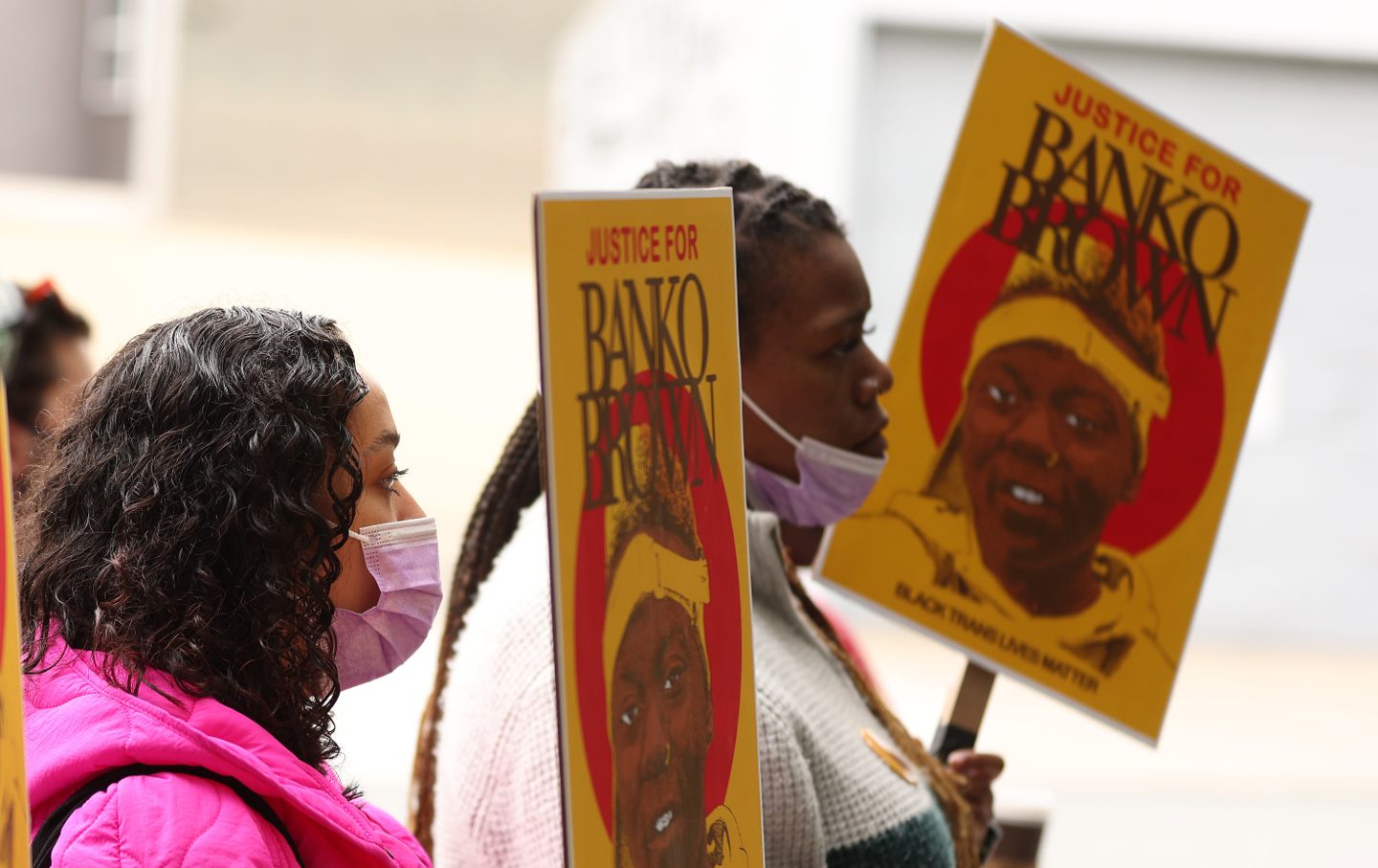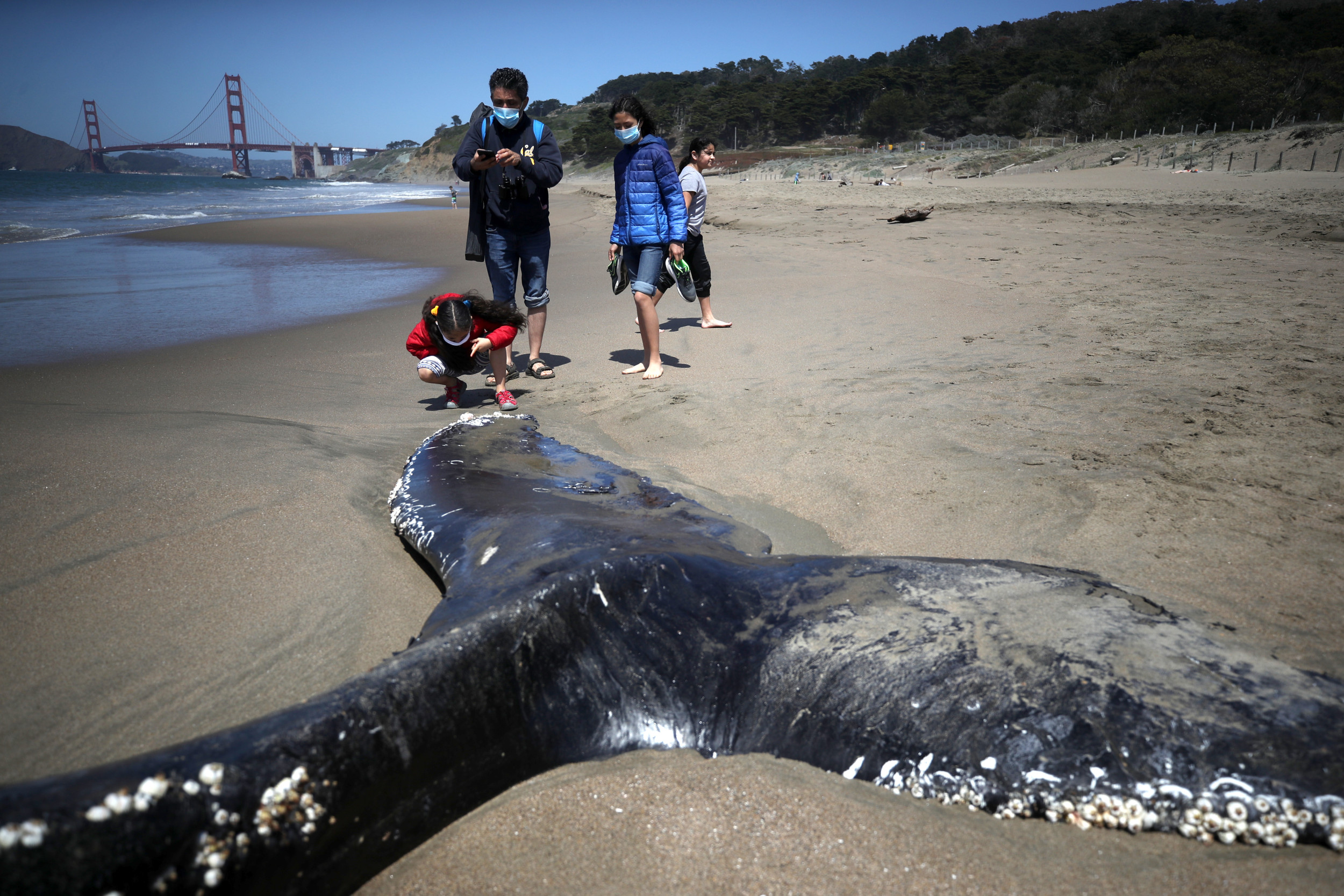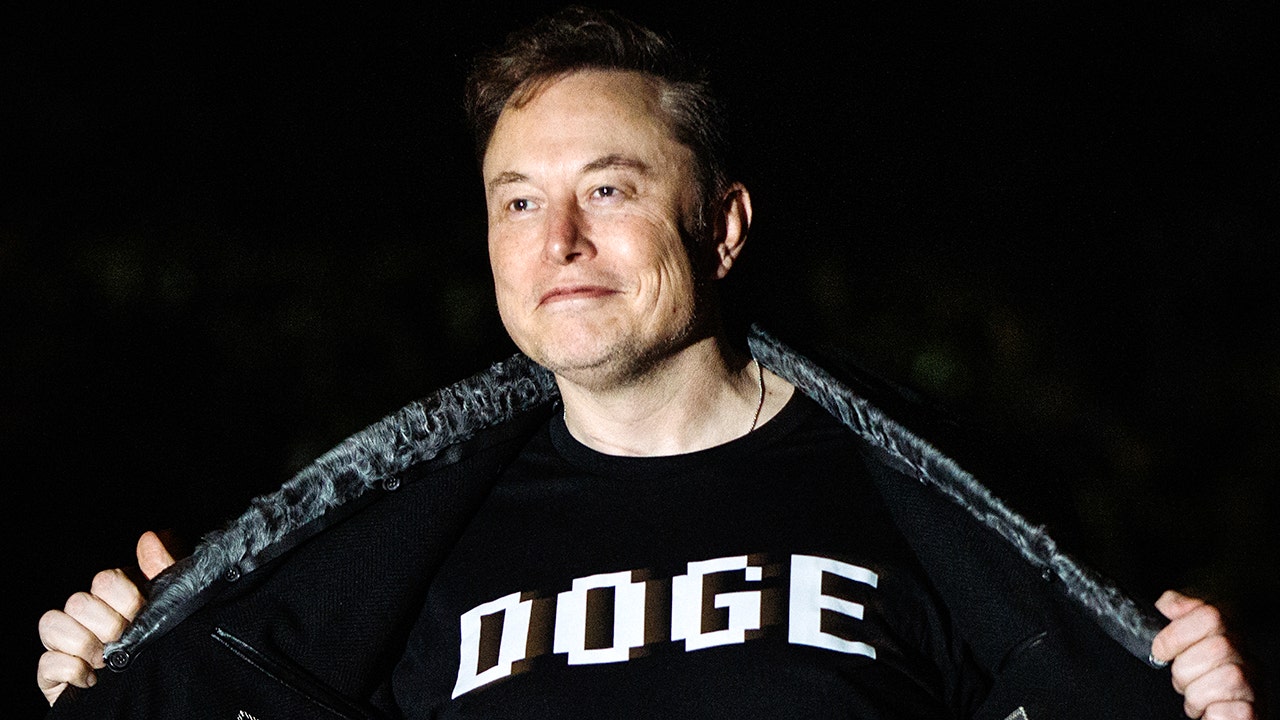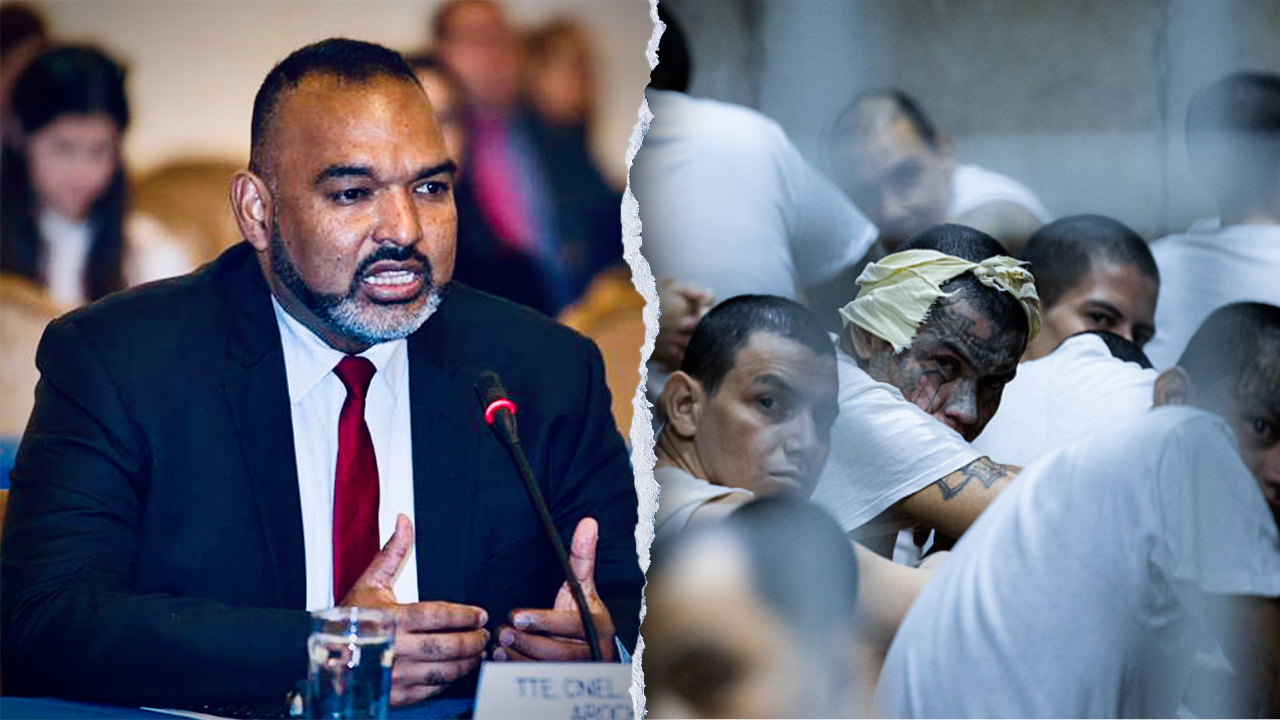San Francisco, CA
The Killing of Banko Brown Shows What San Francisco’s Real Crisis Looks Like

It often feels like not a day goes by without some new story about how San Francisco is in crisis. From Fox News to The New York Times, the national media is laser-focused on highlighting every step of the city’s supposed descent into crime-fueled anarchy.
But the killing of Banko Brown, a 24-year-old Black, unhoused, transgender man, by a Walgreens security guard in downtown San Francisco on April 27 has drawn virtually none of this kind of attention. Even as other incidents of crime in the city, like the killing of tech mogul Bob Lee, made instant international headlines, Brown’s death has remained a local story. Yet anyone looking to understand the real crisis in San Francisco—and the interlocking crises of housing, racism, and transphobia in America—needs to know about what happened to Banko Brown.
In the security-camera footage capturing Brown’s last moments, he’s clobbered to the floor by Walgreens security guard Michael Earl-Wayne Anthony. When Brown manages to stand up, he backs out and away from the store entrance, where Anthony shoots Brown from a few feet away.
Anthony claimed Brown attempted to steal $14 in snacks and soda and then threatened his life. He said he shot Brown in “self-defense,” and cited the recent approval by Walgreens executives of a “hands-on” security approach. (Walgreens has since cut ties with the security firm that employed Anthony.) Though Brown can be seen fighting Anthony’s attempts to subdue him earlier in the footage, he is clearly retreating from the scene at the moment Anthony shoots him. He was unarmed. No one has come forward to corroborate Anthony’s version of events, and the idea that the footage shows him acting in self-defense has drawn deep skepticism even from establishment media outlets.
Nevertheless, District Attorney Brooke Jenkins declined to press charges against Anthony, saying that the threshold for self-defense had been met.
Banko Brown was at the beginning of his life. He had a community that loved him. He was a community organizer with the Young Women’s Freedom Center, an outreach group for women and trans youth. His friends described him as sweet and funny.
But Brown was Black, poor, and trans—a member of three of the most vulnerable and criminalized groups in San Francisco. At every turn, the city made his life more difficult.
Let’s start with housing—the largest expense in San Francisco, where the majority of residents are renters. It is the second-most-expensive place to rent a home in America.
There are 7,754 unhoused people and at least 61,000 empty homes in San Francisco, according to the city’s most recent figures. That means that there are enough vacant units to house San Francisco’s entire unhoused population nearly eight times over. (Recent tech industry flight has undoubtedly increased this number.) But, as the city relentlessly gives itself over to the very richest, poor and working-class San Franciscans are left to subsist on the scraps that remain.
Brown was one of those struggling to survive in this environment. He was reportedly either unhoused or in an insecure housing situation for at least 10 of his 24 years. As The Guardian’s Sam Levin reported, “Banko was recently growing desperate—stuck on [a] housing waitlist, turned away from shelters, sleeping on BART.” Through a megaphone to a crowd at a recent protest, Brown’s friends at the Young Women’s Freedom Center said: “Banko deserved to live…he deserved housing and to have his basic needs met.”
Brown was also suffering from the abandonment and criminalization faced by many queer people and people of color in San Francisco. In America’s queer capital, the city’s own reporting says transgender people are 18 times more likely to be homeless than non-transgender people. (The San Francisco Police Department has misgendered Brown since his death.) Black people are likewise overrepresented among unhoused people, and if you exist at the intersections of Black and trans, the numbers are against you.
Brown had the misfortune of trying to survive at a moment when San Francisco’s harshness towards its most marginalized residents is growing. In 2021, San Francisco Mayor London Breed declared a public health emergency in the Tenderloin, the downtown neighborhood a few blocks away from the Walgreens where Brown was killed. Breed used the very real opioid epidemic as a pretense for the emergency declaration, which unleashed showers of money on the local police. The overdose death toll was also used to justify $68 million in public funding handed to Urban Alchemy, a local nonprofit security company that has been involved in a string of violence and sexual assault scandals. (Breed closed one seemingly effective strategy to combat overdoses–a safe-injection site, where drug users could seek help and sterile needles—in December 2022.)
And this past April, Breed and California Governor Gavin Newsom announced that San Francisco would welcome National Guard troops and members of the state’s Highway Patrol as yet more layers of security to stand watch over the city’s central districts. These old, reactionary tactics from the drug war will certainly claim more low-income drug users as victims.
In September 2022, the Coalition on Homelessness sued the city on behalf of all unhoused San Franciscans, citing “the City’s egregious failure to support affordable housing for San Francisco residents.” In written declarations to the court, ex-staff members of Breed have testified around requests such as the mayor’s desire to have unhoused people removed from her sightline. Mentioned in the case are text messages showing Breed asking police officers to remove specific unhoused people from the streets. A sample: “Man sleeping on bench on Hayes St. near Gough. Can someone come asap, I am in the area having lunch.”
Contributing to the instability are self-deputized neighbors on apps like Nextdoor who frequently attend homeowners association meetings. These are the constituents Breed bends most quickly for. Prior to Breed’s election, Black activists held a banner reading “LONDON BREED DOESN’T CARE ABOUT BLACK PEOPLE” outside one mayoral debate. Breed, who is Black herself, was likely not too troubled by this. Even if she was broadly unpopular with Black residents, it wouldn’t mean much for her political fortunes: Once 20 percent of the city’s population, their numbers bottomed out at 5 percent a decade ago.
Breed now has backup from the district attorney’s office for these moves. In early 2022, she and her supporters focused their sights on the campaign to recall reformist District Attorney Chesa Boudin. Boudin and Breed were not friendly, and when Boudin was ousted after a recall campaign largely funded by out-of-state donors, Breed replaced him with Jenkins, a leader of the recall campaign who had promised to be “tough on crime.” (Friends and family of Banko Brown have pointed out that Jenkins’ refusal to prosecute Anthony sends the message that it is alright to kill unhoused people in San Francisco.)
That said, rulers like Breed know that progressive optics play well in Bay Area politics, but they won’t fight the housing affordability crisis with the most obvious, materially meaningful solution: cheap or public housing. Instead, Breed follows her benefactors from the real estate and security industries, who hawk dressed-up forms of punishment and surveillance to make life miserable for poor people, like new metal barricades meant to discourage sex workers in the Mission district, or “navigation centers,” temporary shelters for unhoused people that are demolished and moved every few years, and keep the city from building permanent low-income housing.
Last week, Walgreens agreed to pay San Francisco $230 million to pay for the opioid bombs the pharmacy dropped in the city. Breed says the money will be used to fund anti-addiction initiatives. Her record indicates it will more likely go to ending the lives of people with addictions, as she funnels money into punitive drug war tactics, hiring police instead of drug counselors, and forcing drug users into locked-down “conservatorship” facilities that disability justice activists have compared to the asylum system of the 1900s.
Brown’s supporters are working to end the conditions that murdered him. After leaving a May 16 meeting of Banko Brown supporters in the city’s Mission district, organizer Jemma DeCristo told me that “Banko Brown had no access to food or safe secure housing,” in a city “where London Breed continues to give millions and millions more to the SFPD, and equally violent proto-police security forces” like Urban Alchemy.
“She may as well have pulled the trigger herself,” DeCristo said.
Michael Earl-Wayne Anthony may have fired the gun that killed Banko Brown on April 27, but politicians who put property values over the lives of people like Brown loaded that gun. Brown was killed because life is dangerous for people who are Black, transgender, and unhoused. He was killed because of negligence from local government heads, who use tough-on-crime rhetoric to justify throwing public money at policing, surveillance, and cruel sweeps of homeless people from sidewalk to sidewalk, all while millions of dollars earmarked for low-income housing sits unused. Breed has a seemingly endless budget for policing. Brown didn’t even have a bed when he was killed.
The forces that caused Banko Brown’s death are ultimately not found on the streets. They are found in the halls of power, in a city overflowing with wealth that refuses to use that wealth for the public good. That—not the scaremongering propaganda you see on television—is the real crisis in San Francisco, for anyone who cares to look for it. That is why Banko Brown is dead.

San Francisco, CA
Scientists investigate as whale deaths surge in San Francisco Bay

A total of 15 whales, including 14 gray whales and one minke whale, have died so far in 2025, according to a joint press release from California Academy of Sciences and the Marine Mammal Center.
“The reason or potential reasons behind the massive spike in sightings this year are still being investigated by researchers,” the release said.
The latest death, a gray whale found in the San Francisco Bay Area on Wednesday, marked the sixth whale death in as many days.
Newsweek reached out via email to the California Academy of Sciences and the Marine Mammal Center on Saturday during non-working hours for more information.
Why It Matters
There has been “unusually high number of sightings” of whales in the region this year but there has also been an increase in deaths. The whale population has seen a 45 percent decrease since the 2019- 2023 Unusual Mortality Event (UME), according to the release.
A record-low number of newborn whales was also seen this year, causing concern among researchers for the long-term outlook for the North Pacific gray whales, following the second UME in a 20-year period.
“These whales basically left the Arctic with a half tank,” Giancarlo Rulli, a spokesperson for the Marine Mammal Center in Sausalito, recently told Phys.org about the other deceased whales discovered in the region.
“The food sources that they were normally accustomed to eating that were highly nutritious for this massive, 10,000–12,000-mile journey, had moved farther away due to climate change, and as a result, these whales were left to forage on food matter that was much less nutritious.”
What To Know
The whale on Wednesday was found near the Alamere Falls in Point Reyes National Seashore, the joint release said, which is about 30 miles northwest of San Francisco.
While some of the deceased mammals have been necropsied, others have either been too far decomposed or stranded in areas that are inaccessible, making it difficult to pin these deaths on one similar cause.
While it is not unusual to see whales in the region as they migrate, the number of deaths is the highest it has been, including in 2019 when 14 whales were found deceased in the UME, according to the release.
The number of deaths currently matches the record of 15 for all of 2021, the release said. At least three of these deaths have been attributed to suspected vessel strikes, but others remain undetermined.
The whales that have been spotted alive have been observed to be either regular size or emaciated.
There are a total of 33 confirmed gray whale sightings in the San Francisco Bay this year, compared to only six seen last year, with about a third of those whales remaining in the bay for about 20 days.
Whale carcasses have been found as far north as Alamere Falls, as far west as Farallon Islands and as inland as Berkeley.
Photo by Justin Sullivan/Getty Images
What People Are Saying
The California Academy of Sciences and partners at The Marine Mammal Center said in the press release: “With San Francisco Bay serving as a shared space for commerce and increased gray whale activity, experts at the Academy and the Center note it’s vital that all boaters—from large commercial vessels to sailboats—be ‘whale aware’ and continue to slow down. Gray whales often have a very low profile in the water that can make them difficult to sight, unlike other coastal whales like humpback whales.”
What Happens Next
The results of the necropsy on the whale found on Wednesday are still pending, complicated by a number of factors due to “inaccessible locations that hinder full post-mortem investigations, as well as poor tissue quality from advanced decomposition, and the lack of available locations to tow for further investigation.”
Meanwhile, the whales that are alive are expected to be in “the bay for another one to two weeks before continuing their annual northern migration to arctic feeding grounds,” according to the release.
If people do see whales, they can report them through an app called Whale Alert or the Marine Mammal Center website. Sightings of dead whales should be reported to the Academy’s department of Ornithology and Mammalogy.
San Francisco, CA
OUSD names former union president as interim superintendent

The Oakland Unified School District Board of Education has picked veteran educator Dr. Denise Saddler to serve as interim superintendent for the 2025/2026 school year.
In their announcement the district said Dr. Saddler was previously the principal at Chabot Elementary School and the Network Executive Officer for the district.
She also spent six years as the president of the Oakland Education Association the union representing thousands of educators in the city.
In addition to her time in Oakland she served as the Assistant Superintendent of Education Services for the Berryessa Union School District in San Jose and has spent the last four years as a lecturer for the U.C. Berkeley Doctoral Program.
The school board is still finalizing the terms of Dr. Saddler’s contract the details of the agreement will have to be finalized at an upcoming board meeting. Dr. Saddler is expected to start on July 1.
She is taking over for Kyla Johnson-Trammell who had her contract terminated earlier this year. She had served as superintendent since 2017 and is reportedly among the longest-serving Oakland Unified superintendents in district history. Her termination came after she had her contract extended by three years back in August.
When Dr. Saddler takes over as interim superintendent she will be inheriting an estimated $95.7 million deficit. Earlier this year board members voted to freeze $29 million something board director Mike Hutchinson said would decimate 50% to 80% of their after-school programs.
San Francisco, CA
San Francisco dog owners urged to stay alert amid coyote pupping season

It’s coyote pupping season, and this is the time of year people may encounter more confrontations with them.
Those at Golden Gate Park recently noticed park rangers educating dog owners about an incident over the past weekend.
Howling coyotes at Golden Gate Park near Lindley Meadows, a popular spot where dog owners walk and play with their pups. Brandon Hartstein and his dog Oden encountered a pack of coyotes in the area about a year ago.
“We were walking on a trail that’s not too popular and all of a sudden, three coyotes just appeared and started kind of stalking us,” said Hartstein.
Similar stories of coyote encounters are surfacing this year. Lauren Roche watched her dog get chased by coyotes.
“She was running along the grassy area and I was running in the path that doesn’t have cars, and there were two coyotes that started chasing after her,” said Roche.
“And I look over, wow, they’re going so fast, and it was two coyotes chasing after her. Luckily, she was fast enough to outrun them, and I called her back over and they ended up going away.”
Signs like these are posted in Golden Gate Park to warn people about these potential run-ins with coyotes. Experts say coyotes are just protective during pupping season and are not displaying unprovoked aggression. They say the best thing to do is to shorten the leash and walk in the other direction. Something Hartstein tried to do.
“We kept on walking away,” said Hartstein. “I was making loud sounds trying to scare them off, and eventually we started running. Luckily, a biker came by and I flagged him down and he helped to chase them off.”
Some dog owners have noticed coyotes getting bolder and becoming used to humans in their territory. They say with these canines all over the Bay Area, the key is to limit conflicts and coexist with each other.
“I just kind of try to adjust my way of living because it’s part of where they live,” said Roche. “I wouldn’t have to adjust for someone coming into my home.”
-

 Education1 week ago
Education1 week agoVideo: Columbia University President Is Booed at Commencement Ceremony
-

 Technology1 week ago
Technology1 week agoAre Character AI’s chatbots protected speech? One court isn’t sure
-

 News1 week ago
News1 week agoRead the Full ‘Make America Healthy Again’ Report
-

 Culture1 week ago
Culture1 week agoHow Manga Megastar Junji Ito Makes Terrifying Series Like ‘Uzumaki’
-

 Technology1 week ago
Technology1 week agoNow you can watch the Internet Archive preserve documents in real time
-

 Technology1 week ago
Technology1 week agoDiscord might use AI to help you catch up on conversations
-

 News1 week ago
News1 week agoVideo: Trump Repeats False Claims to South African President
-

 Science1 week ago
Science1 week agoTrump Has Cut Science Funding to Its Lowest Level in Decades


















